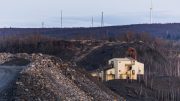No new investment in oil, gas, or coal development, a massive increase in renewable energy adoption, speedy global phaseouts for new natural gas boilers and internal combustion vehicles, and a sharp focus on short-term action are key elements of a blockbuster Net Zero by 2050 report released Tuesday morning by the International Energy Agency (IEA).
The more than 400 sectoral and technological targets in the report would be big news from any source. They’re particularly significant from the IEA, an agency that has received scathing criticism in the past for overstating the future importance of fossil fuels, consistently underestimating the uptake of renewable energy, and failing to align its “gold standard” energy projections with the goals of the 2015 Paris Agreement. For years, the agency’s projections have been used to justify hundreds of billions of dollars in high-carbon investments, allowing multinational fossil companies to sustain the fantasy that demand for their product will increase through 2040 or beyond.
But not anymore.
“Beyond projects already committed as of 2021, there are no new oil and gas fields approved for development in our pathway, and no new coal mines or mine extensions are required,” the IEA writes. “The unwavering policy focus on climate change in the net-zero pathway results in a sharp decline in fossil fuel demand, meaning that the focus for oil and gas producers switches entirely to output—and emissions reductions—from the operation of existing assets.”
“It’s not a model result,” analyst Dave Jones of the clean energy think tank Ember told Bloomberg Green. “It’s a call to action.”
“Big Oil and Gas has just lost a very powerful shield!” wrote Oil Change International Senior Campaigner David Tong.
By 2040, the IEA sees all coal- and oil-fired power plants phased out unless their emissions are abated by some form of carbon capture. Between 2020 and 2050, oil demand falls 75%, to 24 million barrels per day, gas demand falls 55%, and remaining oil production becomes “increasingly concentrated in a small number of low-cost producers.” OPEC nations provide 52% of a “much-reduced global oil supply” in 2050 and see their per capita income from fossil production decline 75% by the 2030s.
“Within the decade, this will have a significant impact on the price and therefore production levels of oil and gas in Alberta,” said Pembina Institute Alberta Director Chris Severson-Baker. “We can also expect that the purchasers of oil and gas products will increasingly direct their spending on oil and gas produced with the lowest upstream emissions.” That rapid pivot will prompt Alberta to “take action to reduce emissions in the oil and gas sector to remain carbon-competitive as demand declines.”
“This is a huge shift from the IEA and highly consequential, given its scenarios are seen as a guide to the future, steering trillions of dollars in energy investment,” Kelly Trout, interim director of Oil Change’s energy transitions and futures program, wrote in an email. “Oil and gas companies, investors, and IEA member states that have been using IEA scenarios to justify their choices and also say they’re committed to 1.5°C are in a tight spot. Will they follow the IEA’s guidance and stop licencing or financing new fossil fuel extraction, or be exposed as hypocrites?”
“It’s incredibly important that the IEA has gathered together the case for the benefits of making this transition,” Rocky Mountain Institute Managing Director James Newcomb told The Energy Mix. “The key elements they point to—4% higher GDP by 2030, millions of net jobs created, two million fewer premature deaths per year by 2030, and universal energy access—those are all amazing parts of the story. We’re starting to see the multi-dimensional benefits in achieving an energy transition, and it’s exciting that the IEA is bringing us evidence to measure it.”
The IEA’s analysis lays out a cascading series of carbon reduction targets in five-year chunks, reinforcing and, well, modelling its own call for government commitments that emphasize short-term emission cuts alongside the 2050 targets many of them have announced.
Canadian climate and energy campaigners immediately translated the IEA analysis into a call to halt construction on the contentious Trans Mountain pipeline expansion. Kukpi7 Judy Wilson, secretary-treasurer of the Union of B.C. Indian Chiefs, and Eugene Kung, staff lawyer at West Coast Environmental Law, said the report will make it that much harder for the Trudeau government to sell Trans Mountain to an Indigenous consortium or some other buyer as a commercially viable project.
“The feds have said it will operate on a commercial basis,” but this report “makes it way, way less likely,” Kung told The Mix. “Anyone who is willing or considering spending upwards of C$20 billion to buy this pipeline is going to do some due diligence and pretty quickly realize there are other places to invest that money that are going to provide a better return and less risk.”
Trout said the same holds true for new investments in liquefied natural gas (LNG) export facilities that now show up as a “very stupid bet”, with LNG declining 60% between 2020 and 2050. “It’s apparent that new LNG projects in Canada contradict the country’s climate commitments, on top of being a major stranded asset risk,” she wrote.
‘Historic’ Investment Surge Creates Millions of Jobs
The report calls for a “historic surge” in renewable energy investment, with public and private finance tripling to US$4 trillion per year by 2030. (Another reference on the IEA site puts the annual total at $5 trillion at decade’s end.)
“This will create millions of new jobs, significantly lift global economic growth, and achieve universal access to electricity and clean cooking worldwide by the end of the decade,” the agency writes. “All the technologies needed to achieve the necessary deep cuts in global emissions by 2030 already exist, and the policies that can drive their deployment are already proven.”
But to get those short-term emission reductions, the IEA’s net-zero pathway “requires all governments to significantly strengthen and then successfully implement their energy and climate policies,” the agency states. “Commitments made to date fall far short of what is required,” with more countries pledging net-zero emissions but most of those promises “not yet underpinned by near-term policies and measures. Moreover, even if successfully fulfilled, the pledges to date would still leave around 22 billion tonnes of CO2 emissions worldwide in 2050,” enough to drive a devastating 2.1°C of average global warming by 2100.
“The scale and speed of the efforts demanded by this critical and formidable goal…make this perhaps the greatest challenge humankind has ever faced,” said IEA Executive Director Fatih Birol.
“The way we see this scenario is that it’s a very, very narrow pathway,” added IEA Chief Energy Modeller Laura Cozzi, “but it’s still feasible.”
In what some analysts see as a serious gap in the IEA’s thinking, the scenario relies increasingly on emerging technologies as the middle of the century approaches. “Most of the reductions in CO2 emissions through 2030 come from technologies already on the market today. But in 2050, almost half the reductions come from technologies that are currently at the demonstration or prototype phase,” the agency writes, in an unfortunate echo of U.S. climate envoy John Kerry’s remarks to BBC over the weekend.
“Major innovation efforts must take place this decade in order to bring these new technologies to market in time,” the IEA writes.
“I strongly disagree with that,” replied Sven Teske, research director at Australia’s Institute for Sustainable Futures, in a statement to The Mix. “The main technologies to decarbonize the global energy system are market-ready, and are either already cost competitive or will be within the next five to 10 years. They are: solar and wind technologies, battery technologies, electric mobility, and various technologies to provide industrial process heat. There is no need to wait for more research. The transition to a full renewable energy supply until 2050 can start now.”
Over the longer haul, Teske agreed that “research and development is key for the energy transition. But it can and must be carried out in parallel to the implementation of new technologies. There is no need to wait for a technical miracle— we have all required technologies at hand to successful implement the first 10 to 15 years of the IEA’s Net Zero Roadmap.”
The report shows global demand for critical minerals like copper, cobalt, manganese, and rare earth metals growing almost seven-fold this decade, exceeding revenue from coal mining well before 2030. “This creates substantial new opportunities for mining companies,” the agency writes. “It also creates new energy security concerns, including price volatility and additional costs for transitions, if supply cannot keep up with burgeoning demand.”
And it points to serious issues for communities and organizations dealing with the often horrid environmental impacts and human rights records of extractive industries. “On one hand, the report is a real victory,” Jamie Kneen, communications and outreach coordinator at MiningWatch Canada, told The Mix. “Reality is finally setting in, which is great. But to the extent that they’re still modelling growth and over-consumption, we’ve still got a lot of work to do.”
Without addressing that more fundamental issue, he added, “it starts to sound more like a proposal to save capitalism than a proposal to save the planet.”
The analysis shows behavioural changes in advanced economies—replacing car trips with walking, cycling, or transit, and flying less—accounting for 4% of projected emission reductions through 2050. But consumer choices like home retrofits, heat pump installations, and electric vehicle purchases account for about 55% of the total.
Getting to 2050, Five Years at a Time
The report lays out the IEA’s pathway to zero in five-year chunks.
• In 2020, emissions stood at 33.9 billion tonnes of carbon dioxide or equivalent, with building retrofit rates below 1%, solar and wind delivering nearly 10% of the world’s power generation, electric vehicles accounting for 5% of global auto sales, and fossil fuels providing nearly 80% of total energy supply. Staying on a net-zero path will require “the massive deployment of all available clean energy technologies—such as renewables, EVs, and energy-efficient building retrofits—between now and 2030,” the agency writes. “For solar power, it is equivalent to installing the world’s current largest solar park roughly every day.”
• As of 2021, no new oil and gas projects, coal mines, or unabated coal power plants are approved for development, and global sales of fossil fuel boilers end by 2025.
• By 2025, emissions fall to 30.2 billion tonnes, all new buildings in advanced economies are zero-carbon-ready, solar and wind hit 20% of global power production, and the last unabated coal plants under construction are completed.
• By 2030, emissions fall to 21.1 gigatonnes, 60% of global car sales are electric, global coal demand has fallen 50% since 2020, advanced economies have phased out unabated coal power, solar and wind are adding 1,020 gigawatts of new capacity per year, 850 gigawatts of hydrogen electrolyzers have been deployed, and everyone in the world has access to energy, in line with the United Nations Sustainable Development Goals.
• By 2035, emissions are down to 12.8 Gt, global fossil fuel use is down 50% since 2020, electricity generation in advanced economies has hit net-zero emissions, internal combustion cars are no longer available, 50% of heavy truck sales are electric, all new industrial motors are best in class, and the model calls for four billion tonnes of carbon capture.
• By 2040, emissions stand at 6.3 Gt, oil demand is down 50% since 2020, all unabated coal- and oil-fired power plants have been phased out, half of all existing buildings have been retrofitted to zero-carbon-ready levels, about 90% of today’s heavy industrial equipment has been replaced as it reached the end of its investment cycle, half of aviation fuels are low-emission, and global electrolyzer capacity has reached 2,400 GW. With electricity assuming a dominant role in buildings, transport, and industry, countries “will require huge increases in electricity system flexibility—such as batteries, demand response, hydrogen-based fuels, hydropower, and more—to ensure reliable supplies.”
• In 2045, emissions fall to 2.5 billion tonnes, new energy technologies are widespread, and low-emission industries are flourishing. Half of global heating demand is met by heat pumps, and natural gas demand has fallen 50% since 2050. The nuclear industry is somehow adding 24 GW of new capacity and supplying more than 5,000 terawatt-hours of electricity per year, while hydropower output hits 8,000 TWh.
• In 2050, the IEA sees emissions falling to zero, with more than 85% of buildings zero-carbon ready, nearly 70% of global power generation coming from solar and wind, more than 90% of heavy industry deemed low-emission, and 7.6 billion tonnes of carbon capture per year.
A Loud Signal to Investors
Perhaps the most profound impact of the IEA’s new analysis will be its message to investors with trillions of dollars at their disposal, many of whom look to the Paris-based agency for guidance on the future shape of global energy markets. The unmistakable signal is that “we’ll have ongoing investment in production, and especially in emissions control and reducing methane leakage, but no additional investment in new supply is required,” RMI’s Newcomb said.
That shift was already understood by some investors, he added. But “it’s incredibly important that it’s out there in black and white in this report, and it will certainly have a wide impact as it works its way through the financial community.”
“In one fell swoop, the IEA’s definitive new outlook forces meaning into empty net-zero pledges made by governments, finance institutions, and companies in recent years,” said Adam Scott, director of Shift Action for Pension Wealth & Planet Health, in an email statement. “Until now, most of these pledges lacked the required honesty, ambition, and planning detail for achieving their stated objectives, often veering instead into dangerous greenwash.”
But now, “finance institutions can no longer justify lending, underwriting, insuring, or investing in coal, gas, or oil expansion projects, or the infrastructure that facilitates that expansion,” he added. “This isn’t an optional pathway. It’s a roadmap showing the direction we must take in order to prevent the worst impacts of the climate crisis from becoming reality.”
“You could say the IEA is catching up to and building on our message,” wrote Oil Change International’s Trout. And yet, “the IEA still creates too much room for dirty fossil fuels and biofuels to linger.” The report “notes that a faster shift to truly clean energy sources is possible if we prioritize more investment in them. So it’s not a question of what’s possible, but of the political will to make it happen.”
Still Some Gaps in the Vision
Oil Change was one of many organizations that took a victory lap after the report release, but still took the IEA to task for downplaying the growth of renewables and relying too heavily on carbon capture and bioenergy.
“It’s huge to have the world’s most influential energy modellers bolstering the global call to stop licencing and financing new fossil fuel extraction,” Trout said. “However, the IEA still has a ways to go to cast off its fossil fuel roots and prove itself a credible global advisor on climate. If the IEA is serious about steering the world towards a 1.5°C-aligned future, it must put 1.5°C at the heart of all its analysis and communications moving forward,” including its annual World Energy Outlook report.
“By continuing to underestimate wind and solar potential, the IEA is still encouraging dangerous levels of reliance on carbon capture and storage, fossil gas, and bioenergy, technologies favoured by polluting industries but harmful for people,” Tong added. “Gambling the climate on a 4,000% increase in carbon capture and storage by 2030 is extraordinarily risky and, the IEA’s own analysis shows, not necessary. Instead of banking on a consistently underperforming and still polluting technology, the IEA should be accelerating the phaseout of fossil gas and coal by relying on proven wind and solar solutions.”
Newcomb lists electric and hydrogen vehicles, energy efficiency, and the potential for emission reductions by city and regional governments as areas where the IEA’s projections fall short.
“You don’t want to be seen as wildly optimistic,” he said. “But the reality is that wildly optimistic things have actually happened in the last decade in wind and solar and batteries, and we think they’re going to continue to,” with advanced battery chemistries speeding the adoption of EVs over the next decade.
Similarly, while the IEA’s 4% annual improvement in the efficiency of energy use “is okay,” Newcomb told The Mix, it “still leaves significant opportunity.” He pointed to a recent competition in India that produced two new designs for super-efficient, climate-friendly cooling systems that were five times more efficient than today’s standard—adding that the same potential exists in every sector of the global economy.
“It’s difficult from a modelling perspective to get your arms around that, so I’m cutting the IEA a little bit of slack,” he said. “But they’re missing a significant share of the efficiency resource that is available and competitive. Energy efficiency is still the least costly solution, and the IEA’s estimates haven’t tapped that out.”
Voluntary actions by sub-national governments are also tough to factor into national or international models. But “this is one of the most important things that will change in the next few years,” Newcomb said. “The level of commitments is quite significant, and we have the ability now to map those commitments and start to understand their energy and emissions consequences.” Sub-national action is “a major driver, it’s not really highlighted at all in the IEA report,” and “when you’ve got a decade to act, the voluntary actions are one of the fastest ways to make change.”
Mitchell Beer @mitchellbeer
May 19, 2021
This article is republished from The Energy Mix under a Creative Commons license. Read the original article.





